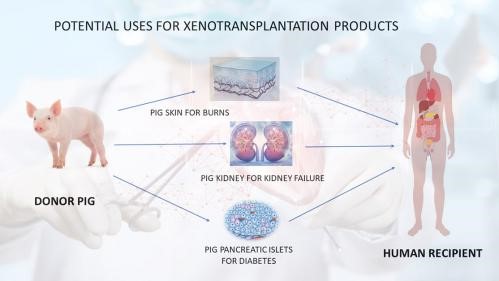
Xenotransplantation

15.05.2024
Xenotransplantation
|
For Prelims: About Xenotransplantation, Why is pig often used for Xenotransplantation? What Methodology is employed in Xenotransplantation? What are the complications in xenotransplantation? |
Why in the news?
Recently, the first recipient of a modified pig kidney transplant passed away around two months after the surgery was carried out.
About Xenotransplantation:
- It is any procedure that involves the transplantation, implantation or infusion into a human recipient of either:
1. Live cells, tissues, or organs from a nonhuman animal source, or
2. Human body fluids, cells, tissues or organs that have had ex vivo contact with live nonhuman animal cells, tissues or organs.
○Xenotransplantation involving the heart was first tried in humans in the 1980s.
- The animal organ selected has to undergo genetic modifications, so that the human body does not reject it.
- Even after the operation, constant monitoring needs to be done to check the body’s response to the organ.
Why is pig often used for Xenotransplantation?
- Pig heart valves have been used for replacing damaged valves in humans for over 50 years now.
- The pig’s anatomical and physiological parameters are similar to that of humans, and the breeding of pigs in farms is widespread and cost-effective.
- Also, many varieties of pig breeds are farmed, which provides an opportunity for the size of the harvested organs to be matched with the specific needs of the human recipient.
- In January 2022, the first xenotransplantation of a genetically-modified pig heart was done.
What Methodology is employed in Xenotransplantation?
- The first step involved genetically modifying the pig organs to be more compatible with humans.
- The kidney used in the new surgery was modified using the gene-editing technology CRISPR-Cas9 to:
- Remove certain pig genes that produce sugars with antibodies our immune systems react to.
- Add certain human genes to improve the kidney’s compatibility with humans.
- Inactivate viruses present in all pig genomes, known as porcine endogenous retroviruses, in the donor pig to eliminate risk of infection in the recipient.
What are the complications in xenotransplantation?
- It has to be ensured that the body does not reject the organ.
- One method of doing this is embedding the pig’s thymus gland, responsible for educating the immune system, underneath the outer layer of the kidney.
- This helps keep away any new or delayed immune responses.
Source: Indian Express
Consider the following statements:
Statement-I
Xenotransplantation involves the transplantation of tissues or organs from non-human animal sources into a human recipient.
Statement-II
Xenotransplantation involves genetic modification of a selected animal organ.
Which one of the following is correct in respect of the above statements?
A.Both Statement-I and Statement-II are correct, and Statement-II is the correct explanation for Statement-I.
B.Both Statement-I and Statement-II are correct, and Statement-II is not the correct explanation for Statement-I.
C.Statement-I is correct, but Statement-II is incorrect.
D.Statement-I is incorrect, but Statement-II is correct.
Answer A